Portable generators are a reliable backup power solution during outages or for off-grid living. Proper setup ensures safety, efficiency, and longevity of both the generator and your home’s electrical system. This guide covers step-by-step installation, essential safety precautions, and expert electrical tips.
Understanding Portable Generators
A portable generator is a compact, fuel-powered device that supplies temporary electricity. Unlike standby generators, portable models require manual setup and fueling. They are ideal for short-term power needs, such as during storms or camping trips.
Key Components of a Portable Generator
Engine: Typically runs on gasoline, propane, or diesel.
Alternator: Converts mechanical energy into electrical power.
Outlets: Provide varying voltages (120V or 240V) for different appliances.
Circuit Breaker: Protects against overloads.
Fuel Tank: Stores energy source; capacity determines runtime.
Choosing the Right Generator for Your Home
Before setup, select a generator that meets your power requirements.
Calculating Power Needs
List Essential Appliances: Refrigerator, lights, furnace, etc.
Check Wattage: Add starting (surge) and running watts.
Select Generator Size: Choose a model with 20% more capacity than your total wattage.
Example:
Refrigerator: 800W (running) + 1,200W (starting) = 2,000W
Lights: 600W
Total: 2,600W → Select a 3,000W+ generator.
Fuel Type Considerations
Gasoline: Readily available but has a short shelf life.
Propane: Cleaner burning, longer storage life.
Diesel: Efficient for heavy-duty use but noisy.
Step-by-Step Setup Guide
Select a Safe Location
Outdoors Only: Generators emit deadly carbon monoxide (CO). Place at least 20 feet from windows/doors.
Dry & Level Surface: Prevents fuel spills and ensures stability.
Ventilation: Avoid enclosed spaces to prevent overheating.
Ground the Generator (If Required)
Check Local Codes: Some areas mandate grounding.
Use a Ground Rod: Connect generator’s grounding terminal to an 8-foot copper rod driven into the earth.
Connect to Home Electrical System
Extension Cords (For Few Appliances)
- Use heavy-duty, outdoor-rated cords.
- Match plug types (e.g., NEMA 5-15 for standard 120V).
Transfer Switch (Safest for Whole Circuits)
Manual Transfer Switch: Installed by an electrician; prevents backfeeding (which can endanger utility workers).
Interlock Kit: A cheaper alternative but requires professional installation.
Start the Generator
- Check oil and fuel levels.
- Turn off all connected appliances.
- Start the generator (follow manufacturer’s instructions).
- Gradually turn on appliances to avoid overload.
Safety Precautions
- Carbon Monoxide (CO) Safety
- Never run a generator indoors.
- Install battery-operated CO detectors near sleeping areas.
Electrical Safety
- Avoid wet conditions—use a generator tent if raining.
- Do not overload circuits.
Maintenance Tips
Regular Oil Changes: Every 50-100 hours of use.
Fuel Stabilizer: Prevents gumming in gasoline engines.
Test Monthly: Ensures readiness during emergencies.
Troubleshooting Common Issues
Generator Won’t Start
- Check fuel and oil levels.
- Inspect spark plug for damage.
- Ensure choke is set correctly.
Power Fluctuations
- Verify load is within capacity.
- Clean or replace air filter.
Conclusion
Setting up a portable generator requires careful planning, proper connections, and strict adherence to safety guidelines. By selecting the right generator, grounding it correctly, and using a transfer switch, you can ensure reliable backup power without risking your home or safety. Regular maintenance will extend its lifespan, keeping you prepared for any outage. For complex wiring, always consult a licensed electrician to ensure compliance with local codes. Stay powered and stay safe!
This guide combines professional electrical knowledge with practical steps, ensuring clarity while maintaining originality for better search visibility. Let me know if you’d like any refinements!

